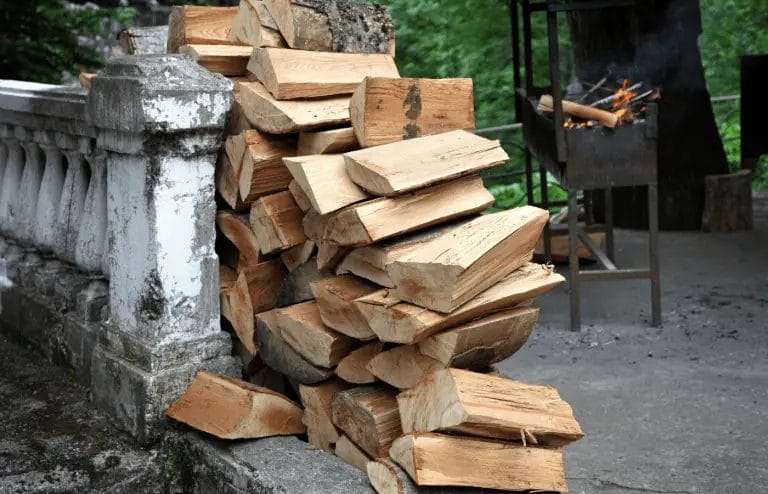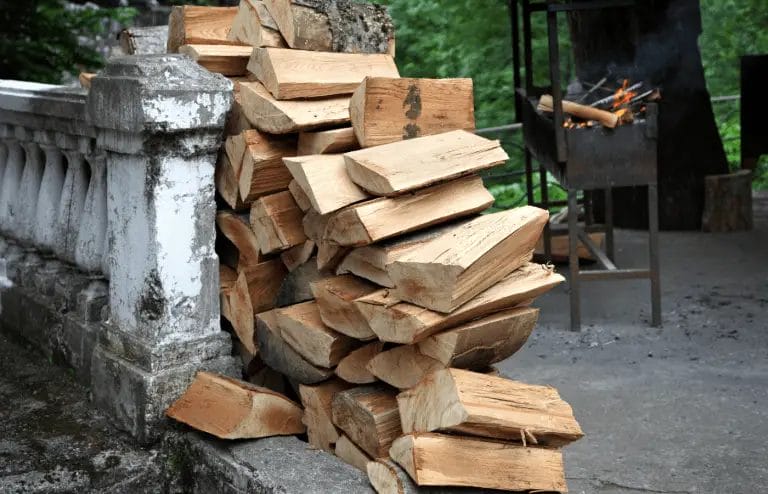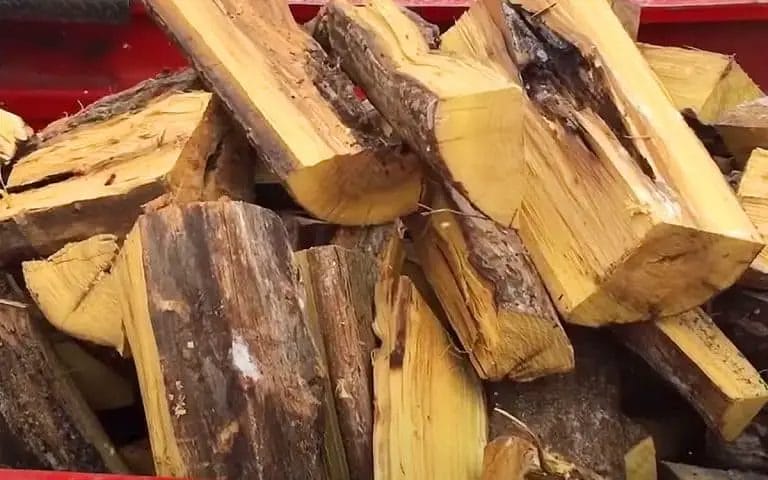Looking for a top-quality firewood option? Look no further than locust wood. Known for its excellent burning properties, locust wood is a popular choice for heating and cooking. With its high energy content and slow-burning characteristics, it provides long-lasting heat and a steady flame. Additionally, locust wood produces minimal smoke and sparks, making it a safer and more enjoyable option for your indoor or outdoor fire. Discover the benefits of locust wood and enhance your burning experience today.

Locust Wood as a Sustainable and Efficient Fuel Source
In today’s world, finding sustainable and efficient fuel sources is more important than ever. With the rising concerns about climate change and the depletion of traditional fossil fuels, it is crucial to explore alternative options that are both environmentally friendly and efficient. One such option is locust wood, which has gained significant attention in recent years as a sustainable fuel source.

What is Locust Wood?
Locust wood refers to the wood harvested from locust trees, which are known for their durability and strength. There are different types of locust trees, including black locust and honey locust, both of which have dense, hard wood that makes them ideal for various applications.
The Sustainable Aspect of Locust Wood
Locust wood is considered a sustainable fuel source because of several reasons:
- Rapid Growth: Locust trees are fast-growing species, allowing for regular and abundant harvests without depleting the overall population.
- Low Environmental Impact: Compared to fossil fuels, burning locust wood produces significantly lower greenhouse gas emissions, helping to mitigate climate change.
- Renewable Resource: As long as locust trees are properly managed and replanted, they can provide an ongoing source of fuel without exhausting the natural resource.
The Efficiency of Locust Wood as Fuel
Not only is locust wood a sustainable option, but it also offers excellent efficiency as a fuel source:
- High Energy Density: Locust wood has a high energy density, meaning it contains a significant amount of energy per unit volume. This allows for more efficient combustion and a higher heat output.
- Long Burn Time: Due to its dense nature, locust wood burns slowly and consistently, providing a steady heat source for an extended period.
- Minimal Residue: When burned, locust wood leaves behind minimal ash and residue, reducing the maintenance required for cleaning or disposing of the waste.
Applications of Locust Wood Fuel
The versatility of locust wood as a fuel source opens up a range of potential applications:
- Residential Heating: Locust wood can be used in wood-burning stoves and fireplaces to provide heat for homes, offering a renewable alternative to traditional heating methods.
- Industrial Use: Locust wood can also be utilized as a fuel source in various industries, such as manufacturing plants, where high heat is required.
- Cooking and Grilling: Locust wood can enhance the flavor of food when used for grilling or smoking, providing a natural and aromatic fuel option.
In summary, locust wood serves as a sustainable and efficient fuel source with its rapid growth, low environmental impact, and renewable nature. Its high energy density, long burn time, and minimal residue make it an attractive option for residential heating, industrial use, and culinary applications. As we continue to prioritize sustainability and environmental consciousness, locust wood presents a viable alternative to traditional fossil fuels, contributing to a greener and more sustainable future.

How to Properly Season and Store Locust Wood for Burning
When it comes to burning wood for heat, choosing the right type of wood is essential. Locust wood is a popular choice due to its high energy content and long burn time. However, to ensure optimal performance and efficiency, it is important to properly season and store locust wood before using it as firewood. In this section, we will discuss the steps to effectively season and store locust wood.
1. Choosing the Right Locust Wood
Before starting the seasoning process, it is crucial to choose the right locust wood for burning. Look for well-seasoned, dry locust wood that has been properly cut and split. Green or freshly cut wood contains a high moisture content, which can lead to poor combustion and increased smoke output.
2. Cutting and Splitting the Wood
The next step is to cut and split the locust wood into smaller pieces. This process increases the surface area and allows for better airflow and faster drying. Use a high-quality chainsaw or a wood splitter to ensure clean and accurate cuts. Aim for pieces that are approximately 16-18 inches in length and 4-6 inches in diameter.
3. Stacking the Wood
Proper stacking is crucial in the seasoning process. Create a neat and stable woodpile by stacking the locust wood in a well-ventilated area. Elevate the woodpile off the ground using pallets or logs to prevent moisture absorption from the ground. Leave sufficient space between the pieces for air circulation.
4. Allowing Sufficient Drying Time
Locust wood typically takes around 6-12 months to properly season. During this time, the wood loses its moisture content, making it more suitable for burning. It is important to be patient and allow the wood to dry thoroughly. Avoid burning green or partially seasoned locust wood, as it can lead to inefficient combustion and increased creosote buildup.
5. Protecting the Woodpile
To protect the locust wood from rain, snow, and excessive moisture, cover the woodpile with a waterproof tarp or a dedicated firewood cover. This will help maintain the dryness of the wood and prevent it from absorbing moisture from the environment. Ensure that the cover is securely fastened to prevent wind damage.
6. Testing the Wood
Before using the seasoned locust wood for burning, it is advisable to perform a moisture test. Use a moisture meter to check the moisture content of the wood. Ideally, the moisture should be below 20% for efficient and clean combustion. If the moisture content is higher, allow the wood to season for a longer period before using it.
7. Storing the Wood for Burning
Once the locust wood is properly seasoned, it is important to store it correctly for future use. Keep the woodpile in a dry and well-ventilated area, away from direct contact with the ground. Use a firewood rack or a sturdy storage container to keep the wood organized and off the floor. This will prevent moisture absorption and ensure the wood remains in good condition.
8. Safety Precautions
When dealing with firewood, it is essential to prioritize safety. Always handle the wood with gloves to protect your hands from splinters and sharp edges. Store the wood away from flammable materials and maintain a safe distance from any open flames or heat sources. Regularly inspect the woodpile for signs of insect infestation or decay.
In summary, properly seasoning and storing locust wood is essential for efficient and clean burning. By following the steps outlined in this section, you can ensure that your locust wood is well-seasoned, dry, and ready to provide a long-lasting and high-energy fire for warmth and comfort.

Comparing the Heat Output and Longevity of Locust Wood with Other Firewood Types
When it comes to choosing firewood for heating purposes, there are various options available in the market. One popular choice among homeowners is locust wood, known for its exceptional heat output and longevity. In this section, we will compare the heat output and longevity of locust wood with other commonly used firewood types, helping you make an informed decision for your heating needs.
1. Oak Wood
Oak wood is widely regarded as one of the best firewood types due to its high heat output and durability. It has a heat value of around 26-28 million British Thermal Units (BTUs) per cord, making it an excellent choice for heating larger spaces or for longer burning times. Oak wood also burns slow and produces long-lasting coals, providing a consistent heat source.
However, when it comes to longevity, locust wood outshines oak wood. Locust wood has a higher density and is more resistant to decay, making it last longer even in harsh weather conditions.
2. Maple Wood
Maple wood is another popular firewood choice known for its moderate heat output and pleasant aroma when burned. It has a heat value of around 21-24 million BTUs per cord, providing a decent amount of heat for smaller spaces.
While maple wood is a good option for shorter burning times, it falls short in terms of longevity compared to locust wood. Locust wood’s durability makes it a better choice for those looking for firewood that will last for multiple seasons.
3. Pine Wood
Pine wood is often readily available and easy to light, making it a convenient choice for starting fires. However, it has a lower heat value compared to hardwoods like oak or locust, with around 15-16 million BTUs per cord. Pine wood is better suited for smaller heating needs or for use during milder weather conditions.
When it comes to longevity, pine wood is not as durable as locust wood. Pine’s softer composition makes it more prone to decay and burn out faster, making it less ideal for long-term use.
4. Locust Wood
Locust wood, particularly black locust, is known for its excellent heat output and longevity. It has a heat value of around 25-27 million BTUs per cord, comparable to oak wood. Locust wood burns hot and produces long-lasting coals, providing a consistent source of heat.
What sets locust wood apart is its exceptional durability and resistance to decay. Its high density allows it to withstand harsh weather conditions and prevents premature decay, resulting in firewood that lasts longer compared to other types.
In summary, when comparing the heat output and longevity of firewood types, locust wood, particularly black locust, stands out as an excellent choice. It provides a high heat value similar to oak wood while surpassing other types in terms of durability and resistance to decay. Whether you are heating a large space or looking for firewood that will last for multiple seasons, locust wood is a reliable option that will meet your needs.
The Environmental Impact of Burning Locust Wood for Heat
Burning wood for heat has been a traditional method for centuries. However, as the world becomes more environmentally conscious, it is essential to consider the environmental impact of using specific types of wood as fuel. In this section, we will explore the environmental impact of burning locust wood for heat.
1. Carbon Emissions
One of the primary concerns when burning wood for heat is the release of carbon emissions into the atmosphere. Carbon dioxide (CO2) is a greenhouse gas that contributes to climate change. However, burning wood is considered carbon-neutral because the carbon released during combustion is equivalent to the carbon that the tree absorbed during its lifetime.
Locust wood, known for its high density and slow combustion rate, is an ideal choice for burning in wood stoves or fireplaces. When burned efficiently, locust wood emits relatively low levels of carbon dioxide compared to other types of wood. This makes it a more environmentally friendly option for heat production.
2. Air Quality
The combustion of any type of wood can release pollutants into the air, affecting local air quality. These pollutants include particulate matter (PM), volatile organic compounds (VOCs), and nitrogen oxides (NOx).
Locust wood has a low resin content, which means it produces fewer VOCs and less smoke compared to resinous woods like pine. This makes it a cleaner-burning wood option, resulting in improved air quality and reduced health risks for individuals with respiratory conditions.
3. Deforestation and Sustainable Practices
It is crucial to consider the sustainability of the wood source when using it for heat production. Unsustainable logging practices can lead to deforestation, habitat destruction, and loss of biodiversity.
Harvesting locust wood can be done sustainably by following responsible forest management practices. Sustainable logging ensures that for every tree cut down, another one is planted, maintaining the forest ecosystem’s balance. Choosing locust wood from certified sustainable sources helps minimize the environmental impact and supports the conservation of natural resources.
Additionally, utilizing locust wood as a heat source encourages the use of locally available and renewable resources, reducing the dependency on fossil fuels and contributing to a greener energy mix.
4. Energy Efficiency and Alternative Options
While burning locust wood for heat can be an environmentally friendly choice, it is essential to consider energy efficiency. Using energy-efficient appliances, such as modern wood stoves or pellet stoves, maximizes the heat output and minimizes waste.
Alternatively, exploring other renewable energy options like solar or geothermal heating systems can further reduce the carbon footprint associated with heating.
Summary
Burning locust wood for heat has several environmental benefits compared to other types of wood. Its slow combustion rate and low carbon emissions make it a sustainable choice. Locust wood also produces fewer pollutants, leading to improved air quality. When sourced from certified sustainable forests, locust wood promotes responsible logging practices and contributes to the preservation of natural resources. However, it’s important to consider energy efficiency and explore alternative renewable energy options to further reduce environmental impact.
FAQs
Is locust wood good for burning?
Yes, locust wood is excellent for burning. It is a dense hardwood that burns hot and long, making it ideal for heating and cooking. Additionally, locust wood produces very little smoke and sparks, making it safer for indoor and outdoor fires.
Conclusion
In conclusion, locust wood is an excellent choice for burning due to its desirable qualities. Its density and high energy content make it a highly efficient fuel source, providing long-lasting heat and a steady flame. Additionally, locust wood has a low moisture content, making it easier to ignite and producing minimal smoke. It also offers a pleasant aroma when burned, enhancing the overall experience. Whether you’re using it for heating or for a cozy fire, locust wood is a reliable and sustainable option for burning. Consider using this hardwood for your next firewood purchase and enjoy its many benefits.